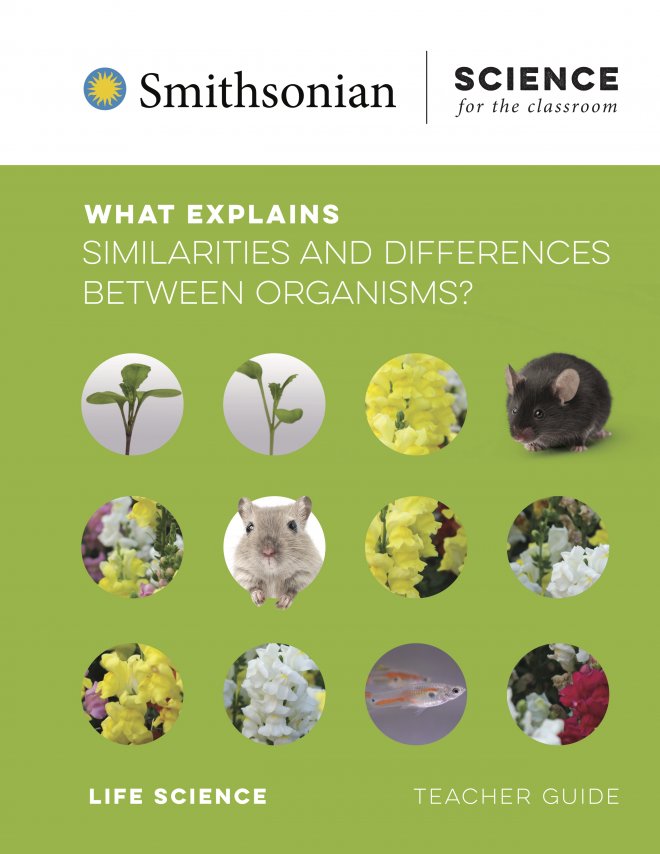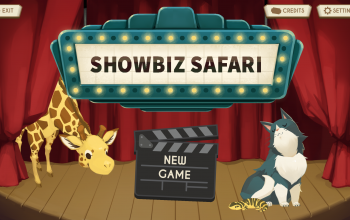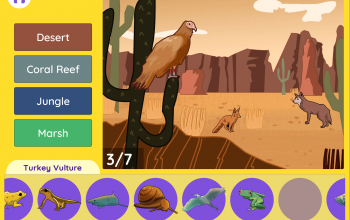What Explains Similarities and Differences Between Organisms?
What Explains Similarities and Differences Between Organisms?
What Explains Similarities and Differences Between Organisms? is part of Smithsonian Science for the Classroom, a brand new curriculum series by the Smithsonian Science Education Center. It is aligned to a group of grade 3 standards. It has a focus on life science with a secondary focus on Earth and space science. In this module, students:
- Make observations of variation in traits in Wisconsin Fast Plants and analyze data for patterns of inheritance
- Collaboratively plan, carry, out and analyze the results of fair tests to see the effect of environmental variables on plant traits
- Analyze average temperature and precipitation data for a range of cities to uncover patterns of climate zones
- Develop a model the represents the stages common to all organisms’ life cycles
- Analyze data from a study on how bees’ preference for certain flower colors gives plants a reproductive advantage
- Construct an explanation for why guppies in some streams are bright orange while others are dull
Below are digital resources that support teaching of this module.
Alike and Different
This file contains photos of individuals within a species that differ from each other in a variety of ways.
Download the Alike and Different PDF
What I Already Know
This file contains photos of two different horses and a map of rainfall totals in Washington State.
Download the What I Already Know PDF
Biodiversity Coloring Book
This link leads to a coloring book featuring organisms from the Biodiversity Heritage Library. Locate “The Birds of Australia” and “Les Orchidees.”
https://www.biodiversitylibrary.org/collection/ColorOurCollections
Condors in Pinnacles National Park
This video shows condors soaring with outstretched wings over Pinnacles National Park.
Download the Condors in Pinnacles National Park Video
Download the Accessible Version of the Condors in Pinnacles National Park Video
Download the Condors in Pinnacles National Park Video Transcript
Sample Pedigree
This file contains a sample pedigree that shows the pattern of inheritance for a particular trait.
Download the Sample Pedigree PDF
Smithsonian Zoo News
This website provides articles about the animals at the National Zoo. Scroll through the articles or use the search function to find articles about parents and offspring.
https://nationalzoo.si.edu/animals/news
Environmental Factors
This video shows several environmental factors that could affect plant growth, including rain, sun, snow, wind, and nutrients.
Download the Environmental Factors Video
Download the Accessible Version of the Environmental Factors Video
Download the Environmental Factors Video Transcript
Temperature Guide
This file provides descriptive terms for a set of temperature and precipitation conditions.
Download the Temperature Guide PDF
Average Temperature Graph for Washington DC
This bar graph shows the average summer temperature in Washington, DC from 1998-2017.
Download the Average Temperature Graph for Washington DC PDF
Summer Temperature and Precipitation Guides
This file provides descriptive terms for a set of summer temperature and precipitation conditions.
Download the Summer Temperature and Precipitation Guides PDF
Map of North American Cities
This map shows the boundaries of countries and states in North America, as well as the location of 16 cites.
Download the Map of North American Cities PDF
North American Koppen Climate Zones
This map of North America uses color to show the range of climate zones, as well as the location of 16 cities.
Download the North American Koppen Climate Zones PDF
Saguaro Range Map
This map displays where the saguaro cactus grows in North America.
Download the Saguaro Range Map PDF
Sugar Maple Range Map
This map displays where the sugar maple grows in North America.
Downloadthe Sugar Maple Range Map PDF
White Oak Range Map
This map displays where the white oak tree grows in North America.
Download the White Oak Range Map PDF
Tilted Trees
These images show two trees that are growing at a sharp sideways angle because of constant wind.
Download the Tilted Trees PDF
Alike and Different
This file contains photos of individuals within a species that differ from each other in a variety of ways.
Download the Alike an d Different PDF
Radish Plant Video
This video shows several radish plant seedlings emerging from the soil and extending their cotyledons (the seed leaves).
Download the Radish Plant Video
Download the Accessible Version of the Radish Plant Video
Download the Radish Plant Video Transcript
Monarch Life Cycle Video
This narrated video from the United States Fish and Wildlife Service shows an adult monarch emerging from a chrysalis and hanging upside-down as its wings expand with fluid.
https://www.youtube.com/watch?v=OM-ptuFr-zc
Bumblebee
This video shows bumblebees interacting with flowers.
Download the Bumblebee Video
Download the Accessible Version of the Bumblebee Video
Download the Bumblebee Video Transcript
Snapdragon Study
This collection of photos shows bumblebees, snapdragon flowers, and the Rocky Mountain Biological Laboratory.
Download the Snapdragon Study PDF
Bumblebee on Snapdragon
This video shows a bumblebee backing out of a snapdragon after collecting nectar.
Download the Bumblebee on Snapdragon Video
Download the Accessible Version of the Bumblebee on Snapdragon Video
Download the Bumblebee on Snapdragon Video Transcript
Aww Snap! A Snapdragon Study
This simulation has students take the role of field researchers to solve the mystery of the white snapdragons. Aww Snap! is available as a website as well as an app on all mobile platforms.
Play the Aww Snap! Simulation
Camouflage
This file contains photos of organisms camouflaged within their environment.
Download the Camouflage PDF
Mouse Investigation
This illustration shows how the light and dark mice look against a sand and a soil environment.
Download the Mouse Investigation PDF
Trinidadian Streams and Guppies
This file contains a map of Trinidad and Tobago, and photos of the field site, scientists at work, and the guppies in the study.
Download the Trinidadian Streams and Guppies PDF
Field Site with Dull Guppies
This video goes underwater to show guppies swimming in a stream.
Download the Field Site with Dull Guppies Video
Download the Accessible Version of the Field Site with Dull Guppies Video
Download the Field Site with Dull Guppies Video Transcript
What I Have Learned
This file shows images for the written assessment, including two bears and a frog life cycle model.
Download the What I Have Learned PDF




Kit Tips & Tricks